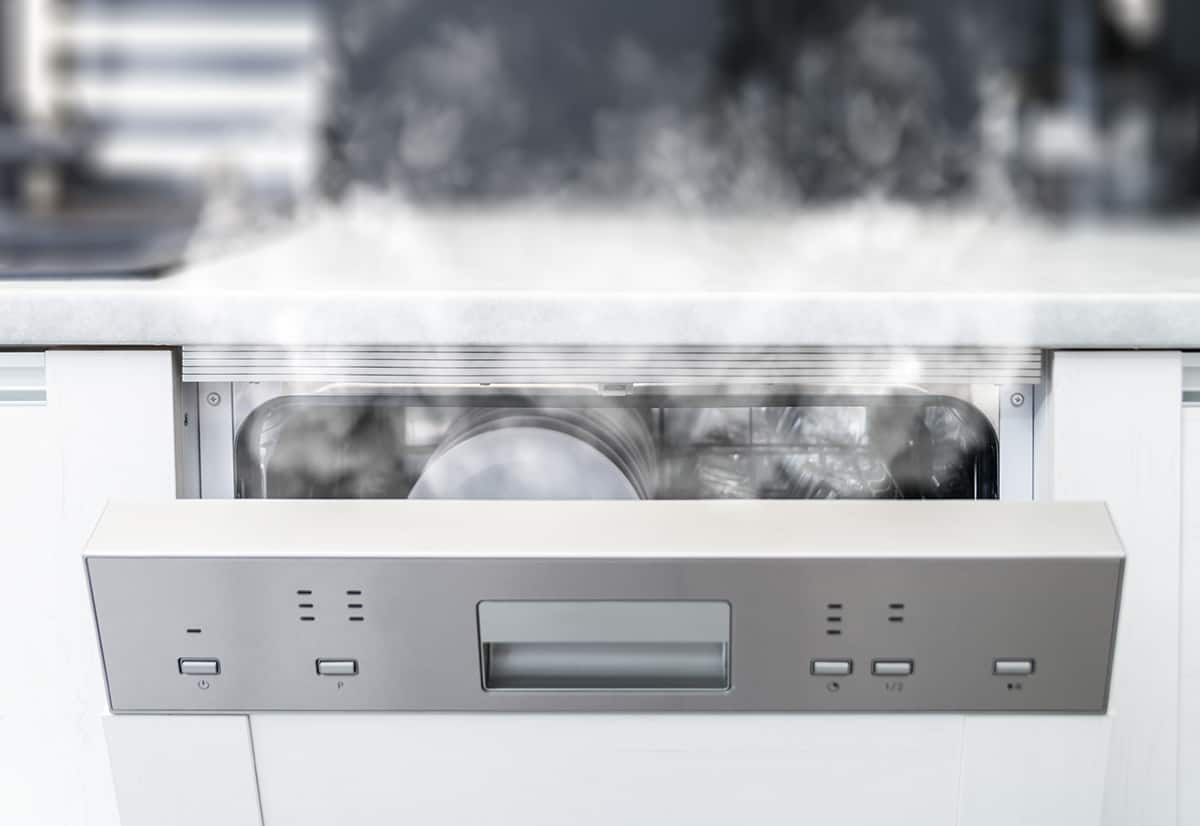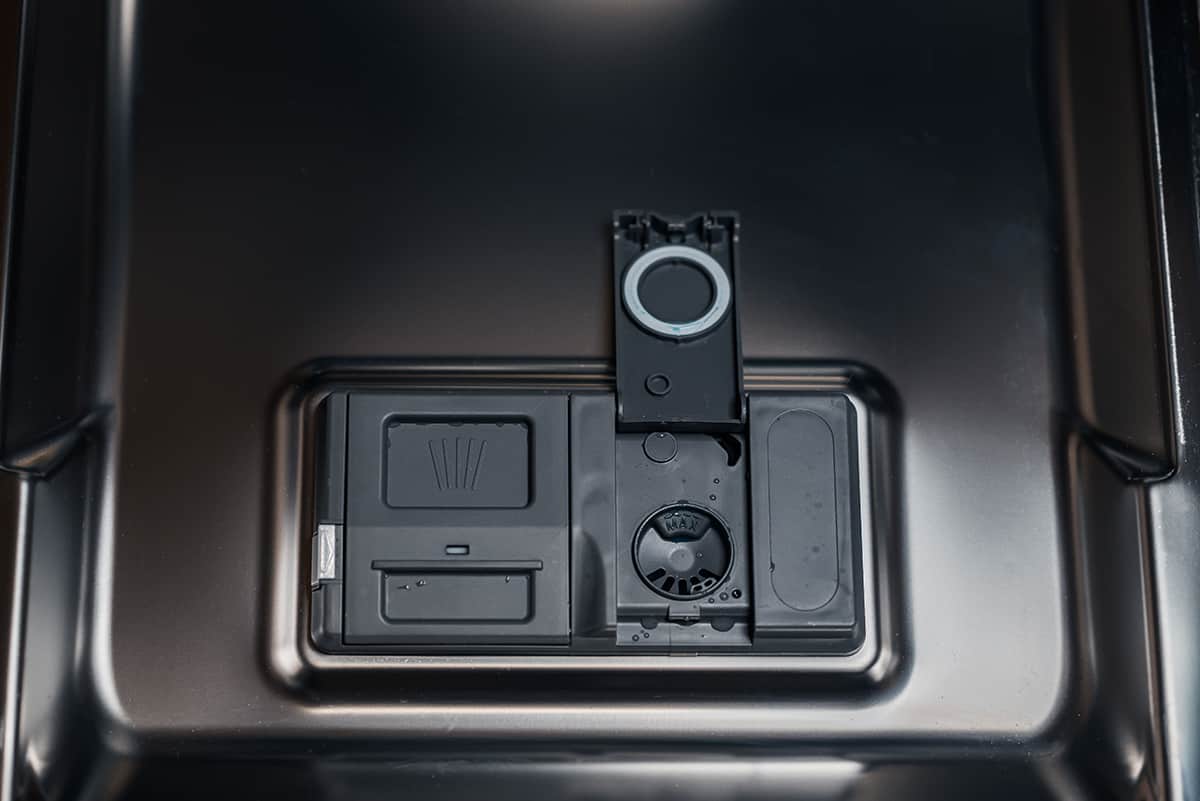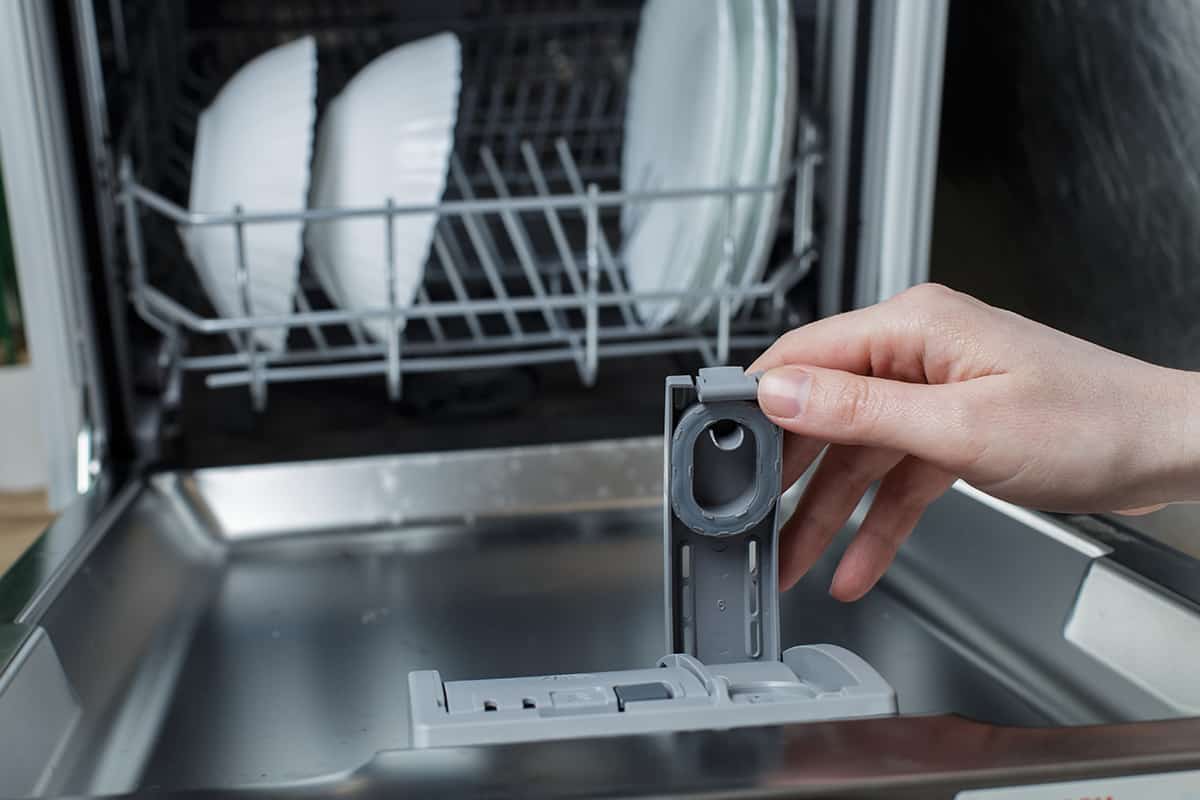Dishwashers are incredibly complex appliances. Everything it does, from filling with water to heating it to the right temperature, is done via its electric control board. So, when does the control board tell the dishwasher to open the soap dispenser?
The soap dispenser on a dishwasher will automatically open during the washing phase after the water has been heated to the appropriate temperature. The spring mechanism on the soap dispenser’s door will disengage, allowing water to pour into the dispenser before the detergent mixes with the water at the bottom of the tub.
In this guide, I’ll explain the entire dishwashing process from start to finish, and I’ll also talk about why your dishwasher’s soap dispenser door doesn’t open.
Dishwasher Process
Have you ever thought about how dishwashers work? Probably not, but I’ll explain anyway. The dishwasher process can be broken into 4 different phases—the pre-rinse phase, the washing phase, the rinsing phase, and the drying phase. However, the number of phases your dishwasher goes through depends on what commands you input into the machine.
Pre-Rinse Phase
Initial filling
After inputting the sequence of wash and add-on commands, the dishwasher will begin to fill with water. Depending on the dishwasher model, it will receive anywhere from 2 to 4 gallons of fresh water from the supply line. The water will fill the bottom of the dishwasher’s tub.
Note: It’s important that you do not pre-rinse your dishes before loading your dishwasher. Many modern dishwashers have sensors that fill the tub up with water based on how dirty your dishes are. Pre-rinsing your dishes may trick your dishwasher into receiving less water than necessary.
Pre-wash spray
The internal spray pump will take the water from the dishwasher’s tub and spray it all over your dishes. Your dishwasher will come with at least 2 spray arms for each dishrack.
Make sure your dishes are loaded in the correct way. Failing to load your dishwasher properly, including overcrowding the dishracks, may prevent the dishwasher from pre-washing your dishes thoroughly. You can check out our guide on overloading a dishwasher to know further about these issues.
Washing Phase
First heating
After the brief pre-wash step, the water will settle to the bottom of the tub. The dishwasher’s temperature control will activate, causing the heating element to increase the temperature of the water. The water is usually heated up to 130 to 140°F.
Mixing soap with the water
In case you’re wondering when the soap dispenser opens in a dishwasher, here it is.
After the water is heated up, the spray pump will turn back on. At the same time, the spring on the soap dispenser’s door will disengage, popping the door forward and allowing water from the spray arms to get into the dispenser. The soapy water trickles to the bottom of the tub, which is then pumped into the spray arms and distributed throughout the tub.
Draining
As all this is happening, the dishwasher’s internal timer will keep track of the duration of the wash cycle. When the pre-programmed time has expired, the spray arms will turn off, forcing all the water down to the base of the tub. The dishwasher’s drain pump will activate, forcing the dirty water past the filter assembly and through the drain line.
Rinsing Phase
Final filling
For the last time, your dishwasher will receive more water from the supply line. Again, it will receive between 2 and 4 gallons of water, depending on the model.
Heating
The dishwasher’s heating element will increase the temperature of the water to a slightly higher degree than the washing phase. After the water is at the correct temperature, the dishwasher’s spray pump will activate again and distribute fresh, heated water throughout the dishwasher.
Drying Phase
Final draining and drying

After your dishes have been thoroughly rinsed, the dishwasher will, for the final time, activate its drain pump to get rid of the water. When all the water has been drained, the dishwasher will turn on.
The residual heat from the rinsing water will draw moisture away from your dishes, which will leave them as dry as a bone after 10 to 30 minutes of waiting. During this time, you should refrain from opening the dishwasher door.
Dishwasher Soap Dispenser Door Not Opening

One clear sign that your dishwasher’s soap dispenser door isn’t opening is that your dishes come out streaky and/or greasy. Since the water can’t mix with the detergent, your dishes won’t get the full washing experience.
So, why isn’t the dishwasher soap dispenser door opening? There are several reasons for this:
Blockage in the door
The first thing you should look for is caked-on debris around the soap dispenser’s door. The debris could prevent the door from opening all the way or opening at all, which will prevent soap from mixing with the heated water.
To get rid of the blockage, take a moistened paper towel and clean the soap dispenser’s door thoroughly. You can also use a bamboo skewer to gently pry away any solid bits of debris keeping the door from snapping open.
Faulty Wax motor
The wax motor is the part of the dishwasher that is responsible for opening the soap dispenser at the right time. If there’s nothing wrong with the door, you should inspect the wax motor for damage.
You can do this by shutting off the dishwasher, unplugging it, opening the dishwasher’s door, and inspecting the wax motor, which is located inside the dishwasher door. You may need to remove the inner door panel to access the wax motor. If a multimeter doesn’t detect continuity, you will need to replace the wax motor.
Faulty bi-metal release
Older dishwashers don’t have wax motors. Instead, they come with a bi-metal release that opens the soap dispenser and keeps it shut. It works similarly to a wax motor, and you’ll need to crack open your dishwasher to locate it.
Open the exterior panel of the dishwasher’s door and locate a metal key-shaped component near the soap dispenser. It’s controlled by an electric motor, which you can test with a multimeter. If it doesn’t detect continuity, you will need to replace the bi-metal release.
Faulty timer
The electric control board is responsible for turning the timer on and off. If the timer is out of whack, it could prevent the soap dispenser from opening at the right time. Fixing this is a huge feat that requires a bit of engineering know-how, so you should leave it up to the pros.
Faulty soap dispenser
Sometimes, the entire soap dispenser mechanism may be broken. This can happen when your dishwasher reaches the ripe age of 10 years and older. However, after the decade mark, you might want to consider getting a new, younger dishwasher model that’s more energy- and water-efficient.
If the soap dispenser isn’t working as it should, you will need to replace the entire component.
Can I Use a Dishwasher with a Faulty Soap Dispenser?
Yes, you absolutely can!
Just because the soap dispenser doesn’t open doesn’t mean the timer, the spray pump, the drain pump, and everything else will stop what it’s doing. While a functioning soap dispenser mechanism is ideal, you can find a way around it and still get the best from your dishwasher.
To use a dishwasher without the soap dispenser, simply add the detergent, pod, or tablet to the bottom of the dishwasher tub. During the initial filling step, the water will mix with the soap. Heated water will eventually dissolve tablets and pods.






